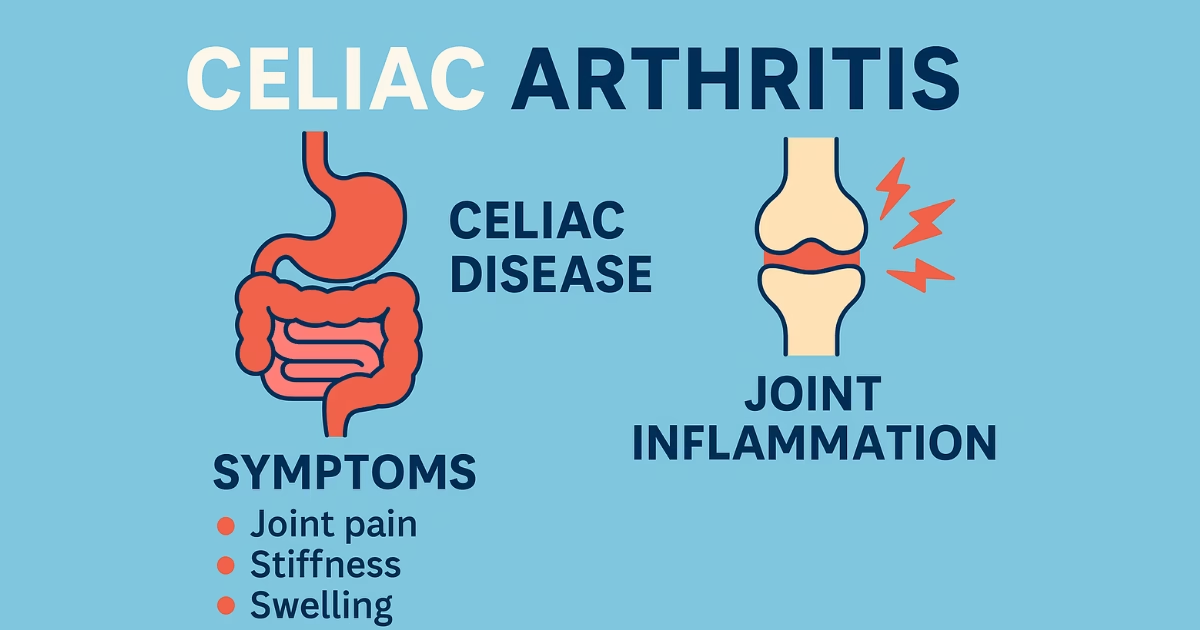Celiac arthritis is a lesser-known yet significant symptom of celiac disease, an autoimmune disorder triggered by gluten. While many people associate celiac disease with digestive issues, it can also cause joint pain and inflammation, often referred to as celiac arthritis. This condition affects individuals with celiac disease, leading to discomfort and stiffness in the joints, which can hinder everyday activities. Understanding the connection between celiac disease and arthritis is crucial for those suffering from these symptoms, as early recognition can lead to more effective management. Although the exact mechanisms behind celiac arthritis are not fully understood, it is believed that the immune response triggered by gluten affects more than just the intestines, extending to the joints. In this article, we’ll explore the symptoms, causes, and treatments for celiac arthritis, and offer advice on how to manage this condition for a better quality of life.
What is Celiac Arthritis?
Celiac arthritis refers to the joint pain and inflammation that some individuals with celiac disease experience due to the autoimmune nature of the disorder. Celiac disease primarily affects the small intestine, causing damage when gluten is ingested, but in some cases, it extends beyond the gut and affects the joints.
While the exact cause of celiac arthritis is not fully understood, it is believed to be a result of the body’s immune system reacting to gluten, causing inflammation in the joints. The symptoms are often similar to those of rheumatoid arthritis, such as joint stiffness, swelling, and pain, but unlike rheumatoid arthritis, celiac arthritis occurs as a consequence of gluten consumption in people with celiac disease.
Joint pain from celiac disease can vary in intensity and may affect different joints in the body, including the knees, hips, and hands. For individuals with celiac disease, this extra-intestinal manifestation can significantly impact their mobility and overall quality of life, often requiring proper treatment and management.
Symptoms of Celiac Arthritis
The symptoms of celiac arthritis can be varied, but they primarily revolve around joint pain, stiffness, and swelling. These symptoms may appear suddenly or develop over time, often coinciding with the consumption of gluten.
Common symptoms include:
- Joint pain: Pain in the knees, wrists, elbows, and hands is common, although it can affect any joint in the body. This pain may be intermittent or persistent, worsening after gluten ingestion.
- Swelling: Affected joints may appear swollen, and there may be visible signs of inflammation.
- Stiffness: Joint stiffness, particularly in the morning, is a common complaint. This can make movements such as walking or bending difficult.
- Fatigue: Those with celiac arthritis may experience unexplained tiredness, which can affect daily activities.
- Limited range of motion: Over time, joint inflammation can lead to a reduction in the range of motion, making it challenging to perform everyday tasks.
Since these symptoms overlap with other forms of arthritis, it can sometimes be difficult to distinguish celiac arthritis from conditions like rheumatoid arthritis or osteoarthritis. However, the key to recognizing celiac arthritis is the presence of these symptoms in someone already diagnosed with celiac disease, especially if the symptoms worsen after consuming gluten.
How Celiac Disease Triggers Arthritis
Celiac disease is an autoimmune disorder in which the immune system mistakenly attacks the body’s own tissues when gluten is consumed. While this damage primarily affects the small intestine, research suggests that the immune response can also extend to other areas of the body, including the joints.
When someone with celiac disease consumes gluten, their immune system produces an inflammatory response that can damage both the intestines and other parts of the body. This inflammatory response may trigger the development of celiac arthritis in some individuals. The inflammation is caused by the immune system attacking the joints, leading to symptoms such as pain, swelling, and stiffness.
It is believed that the chronic inflammation from gluten exposure in celiac disease leads to changes in the synovial fluid and tissues surrounding the joints. This, in turn, causes the characteristic symptoms of celiac arthritis. The body’s immune system mistakenly sees the joints as a target for attack, causing localized inflammation that mimics the symptoms of rheumatoid arthritis.
Diagnosing Celiac Arthritis
Diagnosing celiac arthritis can be challenging due to the overlap in symptoms with other types of arthritis. However, there are specific steps that healthcare providers take to reach an accurate diagnosis.
- Celiac Disease Diagnosis: The first step is to confirm the presence of celiac disease. Blood tests that look for antibodies like tTG-IgA (tissue transglutaminase immunoglobulin A) and EMA (endomysial antibodies) are commonly used to diagnose celiac disease. A biopsy of the small intestine may also be required to confirm the diagnosis.
- Physical Examination: Doctors will examine the joints for signs of swelling, pain, and stiffness. They may assess the range of motion in affected areas and check for any noticeable inflammation or deformity.
- Ruling Out Other Types of Arthritis: To distinguish celiac arthritis from other forms of arthritis, doctors may use imaging tests like X-rays or MRIs to look for joint damage. Blood tests for rheumatoid factor or other markers may also be conducted to rule out rheumatoid arthritis or other autoimmune disorders.
- Tracking Symptoms: It’s important for patients to track their symptoms and note any correlation between joint pain and gluten consumption. This helps healthcare providers better understand the underlying cause and recommend appropriate treatment.
In some cases, if a person is already diagnosed with celiac disease and experiences unexplained joint pain, a trial of a gluten-free diet can help determine if celiac arthritis is the underlying cause.
Treatment and Management of Celiac Arthritis
The primary treatment for celiac arthritis involves adhering to a strict gluten-free diet. By eliminating gluten from their diet, individuals with celiac disease can reduce the inflammation that triggers joint pain. This dietary change can often lead to a significant improvement in both gastrointestinal symptoms and joint pain.
Here are the main treatment options for managing celiac arthritis:
- Gluten-Free Diet: Strictly avoiding gluten is essential for reducing inflammation and preventing joint pain. By doing so, many individuals experience improvement in both the gastrointestinal and musculoskeletal symptoms of celiac disease, including celiac arthritis.
- Anti-Inflammatory Medications: Over-the-counter pain relievers such as ibuprofen or naproxen can be used to manage inflammation and joint pain. In more severe cases, doctors may prescribe stronger anti-inflammatory medications or disease-modifying antirheumatic drugs (DMARDs).
- Physical Therapy: Physical therapy can help improve joint mobility, strength, and flexibility. Exercises that focus on strengthening muscles around the affected joints can help reduce pain and prevent further damage.
- Supplements: Some people may benefit from taking supplements, such as vitamin D and calcium, to strengthen bones and support overall joint health, especially if they have deficiencies due to malabsorption associated with celiac disease.
It’s important for individuals with celiac arthritis to work closely with a healthcare team, including a dietitian and rheumatologist, to develop a comprehensive treatment plan tailored to their needs.
Living with Celiac Arthritis: Tips and Coping Strategies
Living with celiac arthritis can be challenging, but there are several strategies that can help manage the condition and improve quality of life.
- Follow a Gluten-Free Diet: This is the cornerstone of managing celiac arthritis. By avoiding gluten, individuals can prevent flare-ups of joint pain and inflammation. It’s essential to be vigilant about food labels and avoid cross-contamination.
- Exercise Regularly: Gentle exercises like swimming, walking, or yoga can help maintain joint mobility and reduce stiffness. It’s important to listen to your body and avoid overexertion.
- Manage Stress: Chronic stress can worsen inflammation, so practicing stress-reducing techniques such as meditation, deep breathing, or mindfulness can be beneficial.
- Maintain a Healthy Weight: Excess weight can put additional strain on the joints, so maintaining a healthy weight can help reduce joint pain and inflammation.
- Stay Hydrated: Drinking plenty of water can help reduce inflammation and support overall joint health.
By following these strategies, individuals with celiac arthritis can better manage their symptoms and improve their overall well-being.
Preventing Flare-Ups: Can Celiac Arthritis Be Avoided?
The best way to prevent celiac arthritis flare-ups is to strictly adhere to a gluten-free diet. Even small amounts of gluten can trigger inflammation and worsen symptoms. Here are some tips to help prevent flare-ups:
- Avoid Cross-Contamination: Gluten can be hidden in many foods, so it’s important to be vigilant about cross-contamination when preparing meals.
- Monitor Gluten Intake: It’s crucial to read food labels carefully and ask about ingredients when dining out. Many processed foods contain hidden gluten.
- Regular Medical Check-Ups: Regular visits to a healthcare provider can help monitor your condition and prevent complications. Blood tests and check-ups are important for staying on top of both celiac disease and celiac arthritis.
When to See a Doctor
If you experience joint pain, stiffness, or swelling, and are already diagnosed with celiac disease, it’s important to consult with your doctor. Early intervention can help prevent long-term joint damage. You should seek medical advice if:
- Your joint symptoms worsen or become more frequent.
- You experience new symptoms or changes in existing ones.
- There is significant swelling or visible deformities in your joints.
A healthcare provider can help confirm whether you have celiac arthritis and recommend appropriate treatment options.
Conclusion
Celiac arthritis is a challenging but manageable condition for individuals with celiac disease. By understanding the symptoms, causes, and treatment options, those affected can take proactive steps to improve their quality of life. The key to managing celiac arthritis lies in adhering to a strict gluten-free diet, seeking proper medical care, and adopting healthy lifestyle changes. If you suspect that you have celiac arthritis, it’s important to consult a healthcare provider for a thorough evaluation and personalized treatment plan. By managing your celiac disease and joint symptoms effectively, you can live a full, active life despite the challenges posed by celiac arthritis.

Hi, I’m Shafy Ali – a curious mind and passionate writer at Celiac Magazine. I cover a little bit of everything, from everyday tips and how-tos to deeper dives into topics that spark conversation. I enjoy turning research into readable, relatable content that informs and inspires. Whatever the subject, I aim to keep it clear, engaging, and genuinely useful.

